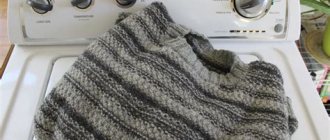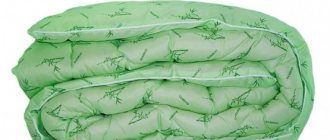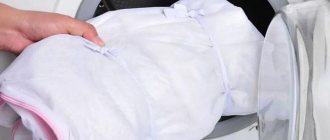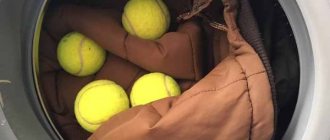Does fleece shrink after washing?
Knitted material is made primarily from polyester. There are also varieties of fleece with a cotton backing, but they are much less common.
During the production process, the synthetic material undergoes wet heat treatment, due to which it becomes resistant to deformation. However, if the care rules are not followed, fleece can shrink greatly in size.
The main reason why a product shrinks is failure to comply with the temperature conditions when washing. If fleece is kept in too hot water, the polyester threads will shrink and the item will shrink one or more sizes.
To return the product to its original size, you need to thoroughly wet it or wash it again. Without squeezing, hang it on a rope to allow the water to drain: the weight of the jets will stretch the fabric.
What kind of fabric is this?
The very name of fleece specifically indicates what effect its creators were trying to achieve - fleece is translated from English as lint or wool. However, the original material was a natural product, but fleece material is made from polyester and some other synthetic threads. The production of this material began in 1979.
The brief description usually states that fleece is as warm a material as wool, without interfering with the body’s ability to “breathe,” which is a very useful addition.
Fleece looks somewhat unusual; its surface is dotted with small lumps, which additionally help retain heat. High heat-saving properties determine the scope of application of this material, but its unusual appearance often forces manufacturers to use it more as a lining. However, the same sweatshirts are quite often made from fleece itself, and it is with the example of such clothing that it is easiest to imagine what it looks like.
How to wash fleece items
For washing, it is better to use liquid detergents for delicate synthetic items. Conventional washing powders dissolve less well, so particles get stuck in the porous material, remaining even after thorough rinsing. As a result, the fleece becomes stiffer and becomes covered with streaks or stains.
To wash fleece items, it is better to use special products:
- Nikwax Polar Proof;
- Nikwax Base Wash;
- “Care and refreshing effect” (Perwoll);
- Micro Wash (Hey-Sport);
- Gallus Sensitive Gel.
After washing, it is recommended to use rinse aids and conditioners that have a “fleece” mark on the label. They will refresh the colors, soften the material, and prevent things from becoming electrified.
Handwash
Manual care usually does not take much effort and time. And if you need to wash a bulky item (a blanket, a blanket or a bulky tracksuit), then this is the only way to clean it.
Progress of the operation:
- Fill a basin or bathtub with warm water (not higher than 30-40 °C).
- Dissolve detergent.
- Soak the product for 20-60 minutes.
- Wash by hand or with a soft brush, avoiding strong pressure on the fabric: with intense rubbing movements, the fibers of the material become thinner, which affects the heat-saving properties and appearance.
- Change the water to clean water and rinse 2-3 times.
- Without squeezing, remove from the water, place on a wire rack or an inverted bowl to drain.
Advice! It is recommended to add fabric softener to the last rinse. The product will soften the fabric, prevent things from shrinking, and reduce the accumulation of static electricity.
History of creation
The softshell appeared when everyone preferred the classic - a three-layer hard windbreaker. It was created according to a special principle:
- The mandatory Gore-tex membrane was ahead of its analogues in its functionality and maintained its leadership among materials for a long time.
- A high level of wind protection and water resistance is both a plus and a minus at the same time, because the latter indicator ensured the heavy weight of the jacket.
However, even Gore was not a champion in the speed of moisture removal during intense physical activity. Another drawback of the membrane was the continuous layer of polyurethane, which could not cope with high humidity.
The question arose: what kind of clothing would combine lightness, waterproofness, impeccable protection from the wind, without turning into a multi-layer bag under which the body does not breathe. In search of an answer, Buffalo employees decided to create an innovative product: they attached Pertex material to the fleece layer. This fabric attracted several advantages:
- Easily and reliably removes moisture, distributing it over the outer surface.
- It had high tensile strength.
- Didn't weigh down clothes.
- Provided protection from the wind.
However, this did not stop softshells from gaining popularity among lovers of light and body-friendly jackets, suits and trousers. The term Soft Shell itself was proposed by specialists from the Patagonia company, which produces a wide variety of wardrobe items created using new technology - for example, light and warm sweaters.
Over time, stretch fabric began to be used in the structure of outdoor clothing, which is characterized by low weight and good performance. Its use helped transform the very silhouette of suits, improve the fit, and make jackets and trousers more comfortable.
- How to wash a jacket on padding polyester: in the washing machine and by hand, drying rules
Along with lightweight softshells, hard ones with a Windstopper membrane also appeared on the market - they were considered poorly breathable and only confused fans of the new technology. However, there were new options that became a step forward for all lovers of comfortable outdoor activities:
- Polartec Power Shield is the most breathable material with high protection against wind, snow and rain.
- Gore-Tex XCR - superior breathability combined with reliable thermal protection.
- eVent is a softshell based on patented membranes that retain moisture well.
At the moment, we can say that the line between Soft Shell and Hard Shell has practically disappeared. There are many offers on the market - they are all divided by purpose and deserve close attention.
Washing fleece in a washing machine
With the right approach, knitted items withstand machine operation very well. Before loading them into the machine, they need to be properly prepared:
- inspect the product, clean the pockets, shaking out dirt and debris from them;
- if necessary, remove stains;
- fasten zippers, hooks, buttons;
- turn inside out.
Advice! It is recommended to pre-soak heavily soiled items in soapy water for 15-30 minutes. You should not soap stains with laundry soap, since the product does not rinse well, leaving streaks.
At what temperature
One of the advantages of fleece is its ease of care. However, it also has a number of features that you need to remember when starting to wash.
The main requirement is the water temperature. It should not be too hot, as the polyester threads may simply melt. The optimal temperature is no higher than 40 °C . At higher rates, the fibers will thin or melt and the knitted product will shrink.
In what mode
The most suitable program for fleece products is “synthetics”, “wool”. The delicate (gentle) or hand wash mode is also suitable.
Spin speed
Fleece does not tolerate intense mechanical pressure well: folds and bruises easily form on its surface. Therefore, it is not advisable to use automatic spinning. If absolutely necessary, it can be turned on, but at minimum speed. Recommended speed - no higher than 400 rpm .
Important! Fleece should not be dried in dryers at high temperatures, as the knit fabric will bunch up and shrink a lot.
What detergent to wash
The right choice of detergents is the key to a long life of fleece. Do not use chlorine bleach. Buy a special powder or gel, conditioner with an “Antistatic” effect. If necessary, use additional means to restore one or another function of the fabric that is impaired upon contact with water.
An alternative to hand washing powder can be regular laundry soap: rub the bar on a grater or crumble it with a knife. Dissolve the resulting mass completely in water and only then add it to the main volume.
Washing a fleece blanket
It is quite difficult to wash a large product by hand, so it is wiser to entrust the operation to a home machine. But before you start washing a fleece blanket in the washing machine, you need to make sure that it fits freely in the drum.
If you have to squeeze it in with difficulty, then it’s better to abandon the idea and wash the blanket the old fashioned way - by hand.
After making sure that the item fits well in the drum, you can start washing:
- load a blanket and 2-3 tennis balls into the washing tank;
- pour in liquid detergent;
- disable spin
- activate the double (additional) rinse function;
- turn on the selected mode (delicate wash, “wool”, “synthetics”).
After finishing washing, transfer the blanket from the washing machine to the bathtub and let the water drain. Hang the wet item out to dry.
How to iron fleece items
Due to the special features of the material, the products do not require ironing. If you wash and dry things correctly, there will be no need for an iron.
If, despite your efforts, the product is wrinkled, then when ironing you should follow the recommendations:
- iron through gauze or iron;
- iron only from the wrong side;
- iron on a board covered with soft material or a terry towel;
- ironing mode – “synthetic”;
- temperature – no higher than 40-60 °C.
Despite the synthetic origin of the material, fleece items are extremely comfortable to wear. Plus, they are easy to care for: you need to remember the characteristics of knitwear and follow the washing recommendations.
Features of fleece drying
After washing, fleece products need to be properly dried. Only horizontal layout is allowed, away from heat sources, otherwise the item may shrink or become deformed. Fleece also does not withstand drying well in direct sunlight. Brightly colored fabrics may lose color, and polyester fibers will lose their softness and heat-saving properties.
Fleece items and clothing are not ironed. After washing, the material is straightened and laid out on a terry towel or sheet to dry. With this method of laying out, the products do not wrinkle and retain their original qualities.
Important! When storing fleece clothing, you should ensure the quality of drying. A raw product will acquire an unpleasant odor in a closed cabinet, which will not be easy to remove.
Fleece products are popular due to the properties of the fiber, and caring for them is not difficult at all if you follow a number of rules. It should be remembered that people with hypersensitivity and small children may experience skin irritation. In this case, you will have to abandon fleece items and choose natural materials.











